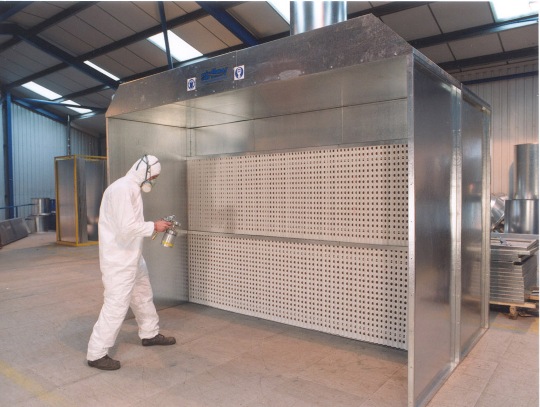Spray booths have a lot of benefits, but they are not magic boxes: There are compliance issues in and around them that employers need to be aware of. Hornell, New York-based Alstom Transportation learned during a recent Occupational Safety and Health Administration (OSHA) inspection that a spray booth is not a fix-it-and-forget-it solution.
 |
As we discussed in yesterday’s article, regulations directly governing spray booths are found in two different places: OSHA’s ventilation standards (29 CFR 1910.94) and spray-finishing rules (29 CFR 1910.107). But those are not the only rules that you need to be aware of if you have a spray booth. Alstom allegedly missed a number of easily correctible compliance issues—it looks as if the company was making a good-faith effort at compliance but didn’t quite cover all of its bases. Here are the spray booth-related deficiencies OSHA observed; don’t miss these areas when you’re finishing up your spray-finishing compliance.
Spray Finishing
Alstom was cited for two violations of the spray-finishing rules—both of these matters that should have been relatively straightforward to fix. Don’t let your spray booth fall short of these basics:
- Clearances. Alstom was cited for an alleged violation of 1910.107(b)(9) for failing to maintain a clear space, free of storage or combustible construction, of 3 feet (ft) in all directions around its spray booth. The inspector alleged that boxes, parts, and other equipment were stored too close to the booth. Empty spaces are always tempting for storage, but don’t let items accumulate close to your spray booth.
- Grounding and bonding. Spray finishing often involves flammable and combustible chemicals, which is why many of the spray booth rules are found in the spray-finishing standards. Alstom was cited for an alleged violation of 1910.107(e)(9), which requires grounding and bonding of containers when flammable liquids are transferred. The inspector noted that Alstom workers failed to electrically interconnect (ground and bond) the containers when transferring flammable acrylic lacquer thinner from a 55-gallon (gal) drum to a 1-gal pail for use in the spray booth. Are your workers strictly observing grounding and bonding work practices?
Respiratory Protection
Another standard that often applies in spray booths is the respiratory protection standard (29 CFR 1910.134). The ventilation system in a spray booth is designed to remove flammable vapors but not necessarily to protect the breathing zone of workers; workers in spray booths must often wear either air-purifying respirators (APRs) or supplied-air respirators (SARs). Alstom provided respirators for its workers, but its overall respiratory protection program was allegedly missing a few pieces. Make sure that your respiratory protection program covers all of its bases by not missing these critical items:
- Fit testing. Workers who wear respirators must be fit-tested, as required by 1910.134(f)(2). One of the workers in Alstom’s spray booth was wearing a 3M half-face piece APR while he mixed paint downwind from a spray painter, but he had allegedly not been fit-tested for it. Is your workers’ fit testing up to date?
- Training. All workers who wear respirators must be trained annually, as required by 1910.134(k)(5); Alstom had allegedly let some of its workers’ training go well out of date. According to OSHA, one worker who was required to wear an SAR in the paint spray area and another who was required to wear a half-face piece APR had not been trained since 2007. When was the last time your workers completed respirator training? Did you miss anyone?
Sprinklers
Spray booths are most commonly equipped with sprinklers for fire suppression purposes. Sprinklers are covered by 29 CFR 1910.159. Alstom’s spray booth was sprinklered—but the employer allegedly failed to maintain it on a regular basis, as required by 1910.159(c)(2). The sprinkler system had not been inspected or flow-tested since 2012. When was your spray booth sprinkler last inspected and flow-tested?
Need more equipment-specific guidance? You’ll be well equipped at Safety.BLR.com®.
